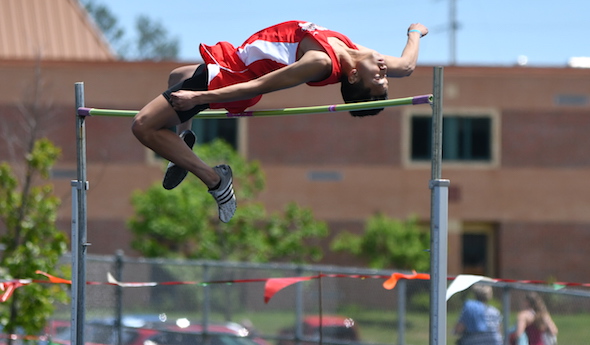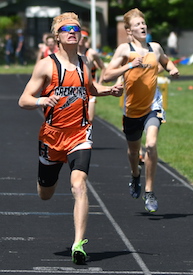
Marquette Rises to Match Challengers
By
John Vrancic
Special for MHSAA.com
June 2, 2018
KINGSFORD — The Marquette boys continued their hold on the Upper Peninsula Division 1 track title Saturday, winning for the fourth straight season with 110 points.
Houghton edged Gladstone 86-76 for runner-up honors.
“Competition in D-1 was the tightest I’ve seen in a long time,” said Marquette coach Kyle Detmers. “It was very competitive. It was a battle until the 3,200 when it was just a seven-point difference between us and Houghton.
“It was just packed. I haven’t been in a D-1 Track Finals that was this competitive to the end.”
Senior Garrett Rudden helped the Redmen gain some separation by placing third in the 3,200-meter run in 10 minutes, 14.41 seconds and helping the winning 1,600 relay (3:35.87). Teammate Garrett Zueger took fourth in the 3,200 (10:28.68) and helped the Redmen take the 3,200 relay (8:30.74).
The Redmen had a double winner in junior Raphael Millado, who captured high jump (6-2) and long jump (19-6).
“Raphael has jumped as high as 6-6 and more than 21 feet (in long jump),” said Detmers. “The wind swirling around down there may have affected the jumping events. We also had a guy (Ethan Martysz) pull up with a hamstring injury in the 100 and pull out of the 200, but the guys fought through it. Drew Thomas taking second in the 110 hurdles and Garrett’s second in the 1,600 were huge for us, and Matt (Pillifant) was seeded seventh and placed fourth in pole vault. We stayed steady and scored in all the field events. I’m thankful for the guys’ resilience and ability to pick each other up. Every point mattered.”
Houghton senior Clayton Sayen won four individual events, taking the 100 (11.47), 200 (23.19), 400 (51.25) and 800 (1:59.31), in the last edging Negaunee senior Colton Yesney (2:00.24).
“It was fun,” said Sayen, who plans to continue his track career at Michigan Tech. “I rely on my speed for everything. I’m thankful for our coaches who always knew that was best for me. Without their guidance, I wouldn’t have been able to achieve what I did. I also want to make a special shout-out to Seth Helman. Running against him in the 800 was a bittersweet moment. He’s my closest friend; I’m really going to miss the time we had together. I’m thankful for the competition we had.”
 Houghton coach Dan Juntilla said he was pleased with the team’s effort.
Houghton coach Dan Juntilla said he was pleased with the team’s effort.
“Our guys gave it their all, but Marquette was a little too deep for us,” he added. “I’m real proud of the guys. Seth and Clayton had a great day, and placing second in the 3,200 relay set the tone. Plus, taking three places in pole vault gave us some big points.
“We’re looking forward to having our new facility next year and really excited about what the taxpayers of Houghton did for us.”
Yesney, who plans to continue his running career at the University of Michigan, won the 1,600 in a school-record 4:23.49 and 3,200 (9:54.43), missing the U.P. meet record by four tenths of a second.
“I’m a little bummed out,” he said. “I thought I had the record. I could envision myself getting the school record in the 1,600. Usually, when that happens it works out well. I thought I had (Sayen) in the 800, but he has that sprinter’s speed and just enough endurance to get it done.
“I’m really looking forward to going to U-M, running for one of the best programs in the nation and running against some of the best runners in the nation.”
Gladstone’s leader was freshman Calvin Thibault, who won the 110 hurdles (16.12) and 300s in a school-record 40.04 seconds.
“I knew what was at stake with us being so close to Marquette (before the 300s),” said Thibault, who’s battling an asthmatic condition. “My family and girlfriend (junior Hannah Christe) were here, and I thought about them during the race. Hannah makes sure I get enough rest and energy to run. At the beginning of the season, I didn’t think I’d be able to do this well, especially in the 300 hurdles. I didn’t know what to expect.”
PHOTOS: (Top) Marquette’s Raphael Millado clears the bar on one of his high jumps. (Middle) Houghton’s Clayton Sayen, left, outkicks Negaunee’s Colton Yesney to win the 800. (Photos by Cara Kamps. Click for more at RunMichigan.com.)

Track Gaining Speed Toward Future with Electronic Starting Devices
By
Steve Vedder
Special for MHSAA.com
May 23, 2023
Aubrey Greenfield thinks it might be the perfect time to reevaluate 130 years of tradition.
For a number of reasons, from technical to personal, the Oxford senior sprinter believes it makes sense for the crack of a starting pistol to be eliminated from high school track meets.
Because track meets would benefit in various ways from lowering costs to easier setup at meets to the human factor of competitors not having to flinch at the crack of a pistol shot, Greenfield believes the sport has a chance to embrace new technology – electronic starting devices (ESD).
In essence, an ESD replaces the starting pistol with a light flash, tone sound or both to begin a race.
"High school sports should put the athlete first," Greenfield said. "We should promote sports, and eliminating starting pistols promotes health in terms of PTSD or trauma for athletes and spectators and that would be good. I would like to think people would say that's a good idea."
In fact, Greenfield would go as far as to say if there was not an implementation of electronic starting devices, many of her teammates would have considered giving up the sport.
"If it's something that helps us compete safely, we're all for it," she said.
Greenfield's opinion apparently is spreading. Michigan High School Athletic Association senior assistant director Cody Inglis said the use of ESD makes it both affordable for meet starters and sensible for athletes and fans to rethink the use of starting pistols. While the MHSAA is not mandating electronic starting devices, it does promote the use of what Inglis calls "emerging technology." He notes that ESD are becoming the norm for organizations such as USA Track & Field, the NCAA and an increasing number of high schools.
 "I think we have to embrace new technology, and we think this will be something that takes hold," Inglis said.
"I think we have to embrace new technology, and we think this will be something that takes hold," Inglis said.
A key part of embracing ESD is the human element. The tragic Oxford High School shooting Nov. 30, 2021, that took the lives of four students while injuring seven others should not be relived even for a fleeting instance at a high school sporting event. Oxford athletic director Tony DeMare said the school began using ESD at every meet, including the MHSAA Lower Peninsula Division 1 Finals last June. He said that decision was embraced by virtually all schools Oxford encountered.
"We were very convinced that the alternative (of ESD) would promote a healthy attitude," DeMare said. "We were overwhelmed with the positive response. If a school was on the fence about it or might not be for it, I think we've started to see the tide turn in favor of people willing to listen and learn about electronic starting devices."
Inglis said the MHSAA is acutely aware of what the crack of a starting pistol can mean to athletes and fans.
"It's unimaginable what Oxford went through, and this is a small way we can help," he said. "We look at a (starting pistol) and think, ‘Could we do something else?’ It's a way of helping to solve a problem."
Over the last several years, the MHSAA has embraced finding an alternative to starting pistols. Inglis noted the discussion started with the cost and diminishing availability of 32-caliber ammunition that meet starters use. A box of ammunition, if it can be found, is around $75 a box.
In addition to cost, there is potential damage from excessive exposure to 150-plus decibels of sound generated by the traditional 32-caliber blanks. Medical studies show damage to ears caused by decibel levels above 120 dB.
The tragedy at Oxford accelerated the conversation.
Inglis said the cost of ESD can be likened to a school sinking money into artificial surfaces at football fields. Yes, there is a great cost at first, but over time money is ultimately saved. An ESD system itself ranges between $200 and $500. Speakers also may need to be purchased, but with ESD starting events like the 800 and 1,600-meter relays positioned near the outside lanes 8, 7, 6 and 5 would result in improved hearing by athletes at the start of a race.
There is one challenge with ESD that track administrators are working to overcome – lighting conditions that lessen the ability to see the ESD’s LED light or strobe when the button is pressed by a starter to begin a race. But that vision difficulty resulting from clear blue skies and backgrounds of setting suns can be substantially improved by incorporating a black background with an ESD – something as simple as a starter holding up black cardboard behind the lighting mechanism at the start of an event.
Inglis said when all factors are considered, the use of ESD makes sense.
 "With the climate we live in nowadays, no lookalike guns is good," he said. "We're not mandating this. But people are saying this is affordable."
"With the climate we live in nowadays, no lookalike guns is good," he said. "We're not mandating this. But people are saying this is affordable."
While switching to ESD would break 130 years of tradition, the timing could be a step forward, said Jeff Hollobaugh, co-author of the book "The Fleet Feet of Spring: Michigan's High School State Championships in Track & Field." He said while no definitive answer is possible, it's likely starting pistols were used at the inaugural state meet at the Jackson Fairgounds in 1895. The meet, which included events like tossing a 16-pound shot put, bike races and a 100-meter sprint, was sponsored by the Michigan Interscholastic Athletic Association (a predecessor to the MHSAA) and comprised mostly of the state's larger schools.
Hollobaugh's sentiments echo what many involved in today's high school track & field believe in terms of making a transition from starting pistols to electronic starting devices.
"It's a change, not necessarily good or bad, just different," he said. "It's not a drastic change, but it will take some getting used to. But it is the future. In the end, we'll all be fine."
DeMare believes the future of high school track will definitely include ESD.
"Our desire is that the practicality and sensibility of this will overcome the alternative," he said. "I think we'll see the automation and electronics taking hold of certain elements in track, and people will embrace it."
PHOTOS (Top) Runners watch official Bertha Smiley as they prepare to begin a race during last season's Lower Peninsula Division 1 Finals at Rockford. (Middle) An electronic starting device provided by VS Athletics was used to start those races. (Below) Smiley sets to begin an event. (Photos provided by David Kuderka/VS Athletics.)

